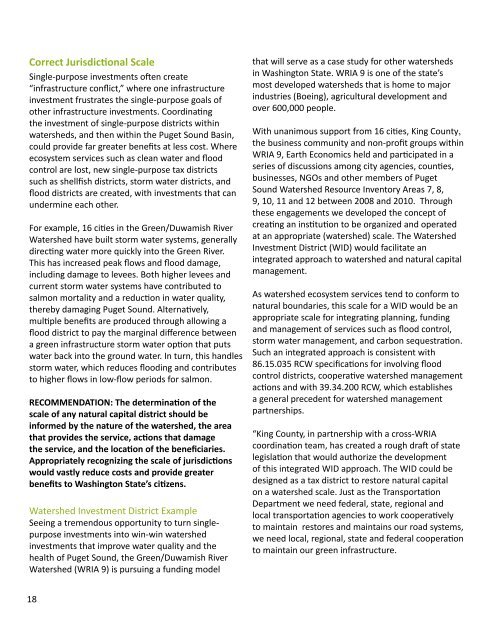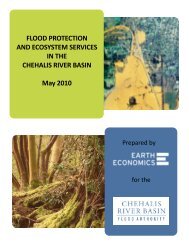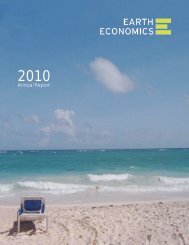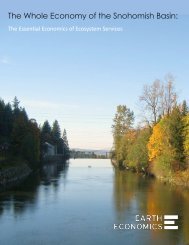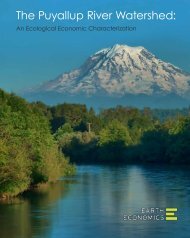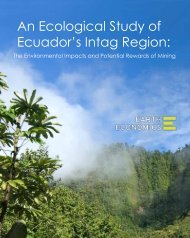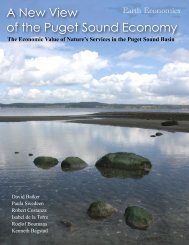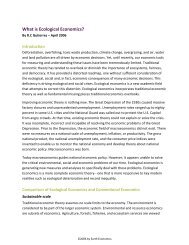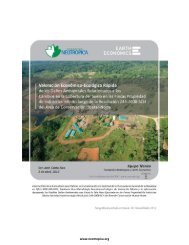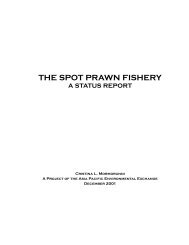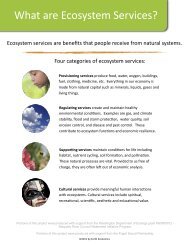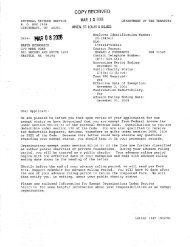Puget Sound: Washington State's Best Investment - Earth Economics
Puget Sound: Washington State's Best Investment - Earth Economics
Puget Sound: Washington State's Best Investment - Earth Economics
You also want an ePaper? Increase the reach of your titles
YUMPU automatically turns print PDFs into web optimized ePapers that Google loves.
Correct Jurisdictional Scale<br />
Single-purpose investments often create<br />
“infrastructure conflict,” where one infrastructure<br />
investment frustrates the single-purpose goals of<br />
other infrastructure investments. Coordinating<br />
the investment of single-purpose districts within<br />
watersheds, and then within the <strong>Puget</strong> <strong>Sound</strong> Basin,<br />
could provide far greater benefits at less cost. Where<br />
ecosystem services such as clean water and flood<br />
control are lost, new single-purpose tax districts<br />
such as shellfish districts, storm water districts, and<br />
flood districts are created, with investments that can<br />
undermine each other.<br />
For example, 16 cities in the Green/Duwamish River<br />
Watershed have built storm water systems, generally<br />
directing water more quickly into the Green River.<br />
This has increased peak flows and flood damage,<br />
including damage to levees. Both higher levees and<br />
current storm water systems have contributed to<br />
salmon mortality and a reduction in water quality,<br />
thereby damaging <strong>Puget</strong> <strong>Sound</strong>. Alternatively,<br />
multiple benefits are produced through allowing a<br />
flood district to pay the marginal difference between<br />
a green infrastructure storm water option that puts<br />
water back into the ground water. In turn, this handles<br />
storm water, which reduces flooding and contributes<br />
to higher flows in low-flow periods for salmon.<br />
RECOMMENDATION: The determination of the<br />
scale of any natural capital district should be<br />
informed by the nature of the watershed, the area<br />
that provides the service, actions that damage<br />
the service, and the location of the beneficiaries.<br />
Appropriately recognizing the scale of jurisdictions<br />
would vastly reduce costs and provide greater<br />
benefits to <strong>Washington</strong> State’s citizens.<br />
Watershed <strong>Investment</strong> District Example<br />
Seeing a tremendous opportunity to turn singlepurpose<br />
investments into win-win watershed<br />
investments that improve water quality and the<br />
health of <strong>Puget</strong> <strong>Sound</strong>, the Green/Duwamish River<br />
Watershed (WRIA 9) is pursuing a funding model<br />
that will serve as a case study for other watersheds<br />
in <strong>Washington</strong> State. WRIA 9 is one of the state’s<br />
most developed watersheds that is home to major<br />
industries (Boeing), agricultural development and<br />
over 600,000 people.<br />
With unanimous support from 16 cities, King County,<br />
the business community and non-profit groups within<br />
WRIA 9, <strong>Earth</strong> <strong>Economics</strong> held and participated in a<br />
series of discussions among city agencies, counties,<br />
businesses, NGOs and other members of <strong>Puget</strong><br />
<strong>Sound</strong> Watershed Resource Inventory Areas 7, 8,<br />
9, 10, 11 and 12 between 2008 and 2010. Through<br />
these engagements we developed the concept of<br />
creating an institution to be organized and operated<br />
at an appropriate (watershed) scale. The Watershed<br />
<strong>Investment</strong> District (WID) would facilitate an<br />
integrated approach to watershed and natural capital<br />
management.<br />
As watershed ecosystem services tend to conform to<br />
natural boundaries, this scale for a WID would be an<br />
appropriate scale for integrating planning, funding<br />
and management of services such as flood control,<br />
storm water management, and carbon sequestration.<br />
Such an integrated approach is consistent with<br />
86.15.035 RCW specifications for involving flood<br />
control districts, cooperative watershed management<br />
actions and with 39.34.200 RCW, which establishes<br />
a general precedent for watershed management<br />
partnerships.<br />
“King County, in partnership with a cross-WRIA<br />
coordination team, has created a rough draft of state<br />
legislation that would authorize the development<br />
of this integrated WID approach. The WID could be<br />
designed as a tax district to restore natural capital<br />
on a watershed scale. Just as the Transportation<br />
Department we need federal, state, regional and<br />
local transportation agencies to work cooperatively<br />
to maintain restores and maintains our road systems,<br />
we need local, regional, state and federal cooperation<br />
to maintain our green infrastructure.<br />
18


